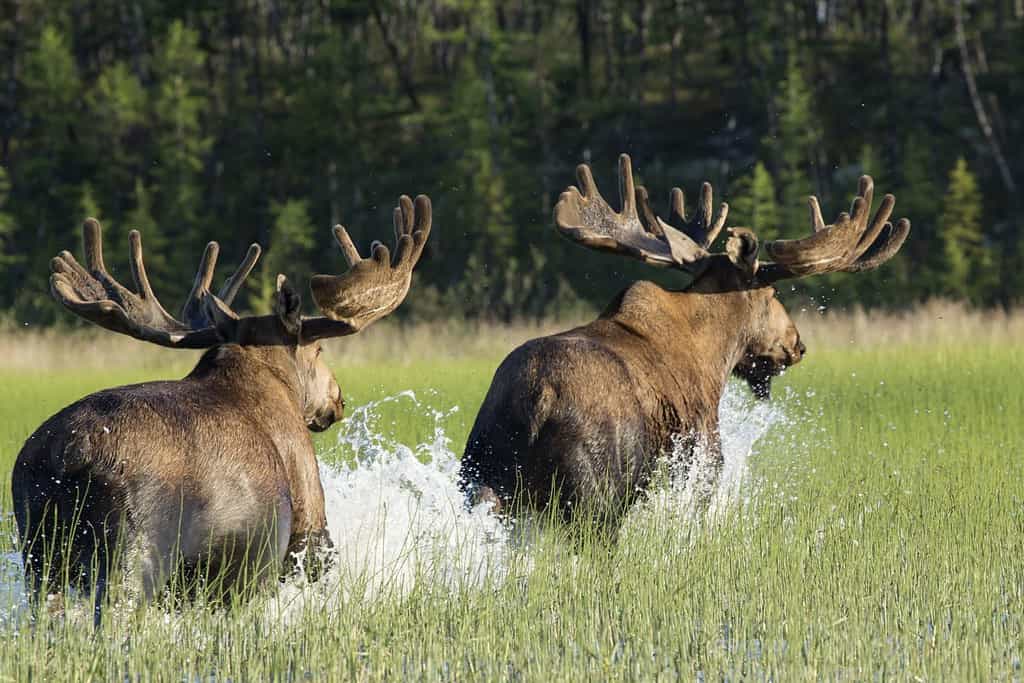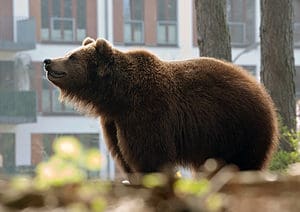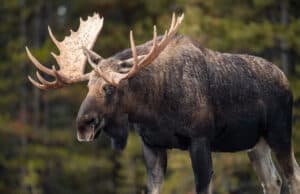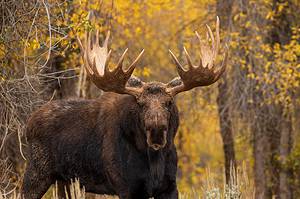Regarding how rare a piebald moose is, we’re talking near mythological status. Piebald moose sightings are exquisitely rare, and those who spot them tend to confuse them with albino moose, a rare class in its own right. The most recent sighting of a piebald moose went viral, if that’s any indication of how rare they are.
In May 2017, Gerald Gale ran into the opportunity of a lifetime, stumbling upon a piebald moose in Newfoundland, Canada. He was able to capture numerous photographs and videos of the moose. Fortunately, considering the circumstances, the moose didn’t seem to mind Gale’s presence and photography work.
Many consider such an event to be a once-in-a-lifetime occurrence. A rare piebald moose doesn’t stumble in front of a camera lens regularly, after all.
What Is a Piebald Moose?
Before diving into its rarity, what makes a piebald moose such an uncommon find? The definition of a piebald animal specifically depicts white spots (areas that lack pigmentation) on otherwise pigmented fur or skin. However, in many cases, these aren’t the kind of small, white spots you typically see on a deer fawn.
The white spots on a piebald moose are typically dominant, with the pigmented areas being a secondary color as the white takes up most of the real estate. The rare piebald moose Gerald Gale caught on camera was not an exception. That’s not to say there aren’t exceptions. Some piebald animals feature a more “half-and-half” look.
Piebald appearances aren’t intrinsic to moose, either. A number of animals end up being piebald, and it’s more or less as rare among them as it is with moose. Snakes, deer, dogs, horses, squirrels, and more are all subject to having a piebald appearance.
Piebald appearances aren’t inherently harmful to the animal, at least not as much as being an albino. A small to severe lack of melanocytes causes the piebald patterning, thanks to the mutation of a gene known as, interestingly enough, “”Kit.”” The exact inner workings of the mutated gene, how it disperses non-pigmented versus pigmented fur, and to what degree is still a work in progress.
How Rare Is A Piebald Moose?

Piebald moose are so rare (less than or equal to 1%) that you’ll be fortunate ever to spot one in the wild.
©Olenyok/Shutterstock.com
As rare as it is and as exciting as it is to spot one, no concrete number covers how occasional a piebald moose is. The closest analysis of the rarity of piebald animals, including moose and other exciting traits, is a compilation from the Hirschfelden Hunting Reserve.
There are other numbers thrown around out there, either by hunting enthusiasts or scientists, and, for the most part, they are similar to the “> or = to 1%” on the Hirschfelden Hunting Reserve website/factsheet. According to the Department of Environmental Protection, piebald deer generally make up less than 1% of their entire population.
With that being said, with moose being a member of the Cervidae (deer) family, the less than 1% statistic is as close to accurate as it gets. The moose population is roughly 1.25 to 1.5 million in America and Canada. If we stick with precisely 1% of the higher number, 15,000 piebald moose are running around.
That sounds like a lot. However, we can break it down even more to give you a clear understanding of how rare the piebald gene mutation is in terms of just moose.
Rare Piebald Moose By Area
Moose are prevalent in 10 states, including Alaska. They are also commonplace throughout Canada. While we can’t accurately break down the number of piebald moose in each state, we can generalize the total number of piebald moose (15,000) spread across the square miles of all ten states and Canada.
| State/Country | Moose Population | Estimated Piebald Moose | Square Miles | Rare Piebald Moose Per mi² | Square Miles Per Piebald Moose |
|---|---|---|---|---|---|
| 1. Alaska | 200,000 | 2,000 | 665,400 mi² | .003 | 332.7 mi² |
| 2. Colorado | 3,000 | 30 | 104,185 mi² | .0002 | 3,472.8 mi² |
| 3. Wyoming | 4,050 | 40.5 | 97,914 mi² | .0004 | 2417.6 mi² |
| 4. New York | 700 | 7 | 54,556 mi² | .0001 | 7793.7 mi² |
| 5. Maine | 70,000 | 700 | 35,369 mi² | .02 | 50.5 mi² |
| 6. Idaho | 12,000 | 120 | 83,642 mi² | .001 | 697 mi² |
| 7. Utah | 3,000 | 30 | 84,900 mi² | .0003 | 2830 mi² |
| 8. Washington | 5,000 | 50 | 71,362 mi² | .0007 | 1427.2 mi² |
| 9. Montana | 5,000 | 50 | 147,040 mi² | .0003 | 2940.8 mi² |
| 10. Vermont | 2,000 | 20 | 9,616 mi² | .002 | 480.8 mi² |
| 11. Canada | 1,000,000 | 10,000 | 3.855 million mi² | .002 | 385.5 mi² |
Obviously, there is no such thing as .0007 rare piebald moose. This number conveys how rare it is to see a piebald moose. We’re dealing with estimates only since no concrete population number is given for any state or country. We’re also excluding migrational patterns, death estimates, and other natural factors that may affect the numbers one way or the other.
Since the piebald mutation isn’t geographically specific, being more or less dependent on the region, we don’t have to worry about a larger prevalence of rare piebald moose in one area than another with a comparable population.
Final Thoughts
If you ever spot a rare piebald moose in the wild, you’ll experience a once-in-a-lifetime event. Even Gerald Gale felt the same way. They may be rare, but the piebald condition has no detrimental effects on the health of the moose or any other animal or human being that has it.
It’s a fascinating realization that spotting a piebald moose is almost as rare as coming across Bigfoot.
The photo featured at the top of this post is © Tori Wilson/ via Getty Images
Thank you for reading! Have some feedback for us? Contact the AZ Animals editorial team.







